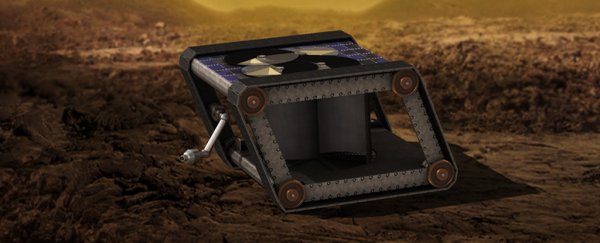Space can be hell, especially for delicate hardware. So when vital instruments need to run like clockwork, sometimes clockwork is actually the solution.
NASA is taking a close look at a design for an off-world rover that's more Mad Max than Star Trek, one that relies on old fashioned mechanics to make calculations under intense conditions that would fry most electronics.
Venus is no place for the weak. Its average surface temperature is a lead-melting 462 degrees Celsius (864 degrees Fahrenheit), making it the Solar System's hottest planet.
Add to that a surface pressure 90 times that of Earth's surface and corrosive clouds of sulphuric acid and you've got one inhospitable world that would make the Martian rover Curiosity shake in its tracks.
The Automaton Rover for Extreme Environments (AREE) was conceived in 2015 by a mechanical engineer named Jonathan Sauder at NASA's Jet Propulsion Laboratory (JPL) in Pasadena, California.
"Venus is too inhospitable for kind of complex control systems you have on a Mars rover," says Sauder.
"But with a fully mechanical rover, you might be able to survive as long as a year."
A year would be a huge improvement on previous efforts. In 1967, Russia's Venera 4 space probe was the first to send back information while entering the planet's atmosphere.
Three years later, Venera 7 successfully made a soft landing, but lasted a paltry 23 minutes before it stopped transmitting.
A fluid-cooled Venera 9 touched down in 1975, sent back a few black-and-white snap-shots of its surroundings, and bit the dust 53 minutes later.
The true champion, however, was Venera 13, which sent back 14 colour and eight black-and-white photographs and analysed a Venusian rock during its two hour life in 1982.
For the past three decades Venus's surface has been relatively ignored as far as landers go, with remote analysis left to orbiters and fly-by missions.
To do much better than a few hours, a whole new way of thinking about space exploration was in order.
"When you think of something as extreme as Venus, you want to think really out there," says Evan Hilgemann, a JPL engineer working on designs for AREE.
"It's an environment we don't know much about beyond what we've seen in Soviet-era images."
AREE is a throwback to age-old calculation devices such as Charles Babbage's 19th century difference engine and the ancient Greek Antikythera mechanism that relied on gears to model celestial movements.
While other plans for future lander missions would rely on advanced cooling systems – technology that would require expensive research and development, and still risk failure – AREE would aim to reduce reliance on electronic components where possible by replacing them with gear-based calculation engines.
As if that isn't steampunk enough, AREE could potentially even communicate by selectively reflecting back signals sent from an orbiter by opening and closer a shutter.
The machine itself would be at least partially powered by a wind turbine, taking advantage of Venus's thick atmosphere. To make it over the rough terrain it would move about on tank-like treads.
A purely mechanical rover like this – while feasible – is unlikely to be practical. At this stage a hybrid is the most likely contender, mixing electronics powered by photovoltaics with mechanics to make the device as robust and reliable as possible.
Sauder's proposal is in the second phase of development as part of NASA's Innovative Advanced Concepts (NIAC) program, which takes out-there concepts and looks for ways to use the fringe thinking to solve problems.
Titan's hydrocarbon lakes, Europa's dark and salty oceans, and even the gas giants' mysterious clouds all hide secrets we're desperate to learn, if only we can build the right tools to withstand their environments.
With such a variety of environments out in the galaxy to explore that make the surface of Mars look like a holiday camp, we're going to need some crazy ideas to get up close and personal with other worlds.
